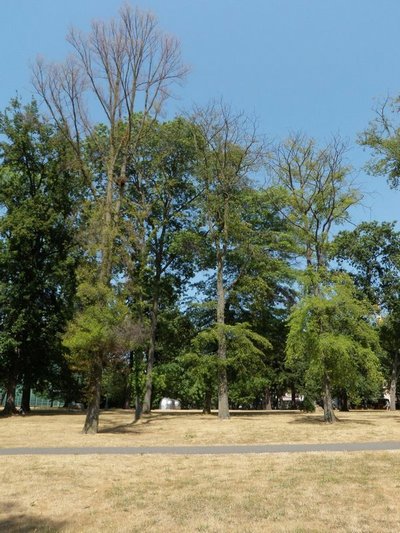August 20, 2009
Dutch elm strikes: A dozen trees near Parrington Hall must be removed
About 12 elm trees between Parrington Hall and the William H. Gates Building will be taken down over the next two weeks because of Dutch elm disease.
“A lot of the elm trees in that location are grafted together by their roots,” said Sara Shores, campus arborist. “They share nutrients, they share water and they also share disease.”
Dutch elm disease is a fungus that gets into the vascular system of the tree, depriving it of nutrients. Once the disease reaches a tree’s roots, the tree will inevitably die. And if, as in the case of these trees, the roots of several trees are connected, all those trees will die.
“The reason why you want to remove them right away is that Dutch elm disease is also transmitted by beetles,” Shores said. “The beetles have two or three generations in summer, so they’re active all the way until October. They could fly 10 miles and spread Dutch elm all over Seattle.”
The beetles, she explained, burrow under a tree’s bark and lay their eggs in what are called galleries. The fungus grows into the galleries, and when the beetles hatch, they crawl through the galleries and pick up the fungus. Then they fly to a healthy tree and transfer the fungus.
This is the first instance of Dutch elm disease detected on campus, although there are about 150 elms here, about 80 of which are larger, more significant trees. Shores said the University has been treating all of its elm trees with a fungicide called Dutch Trig, which is unfortunately not 100 percent effective. Ten of the best specimens get an additional, more expensive treatment called Arbortech. But arborists nationwide have been fighting an uphill battle against the disease, which has been slowly working its way across the country from its first appearance on the East Coast.
Shores said she will be closely monitoring other elms — especially those near these — to see if any of them come up with the disease. A tree with Dutch elm can be saved if the problem is found before it gets into the roots. In that case, only the diseased portion needs to be removed.
Parts of Parrington Lawn will be closed off while the trees are being removed, an operation which is likely to take several days.

